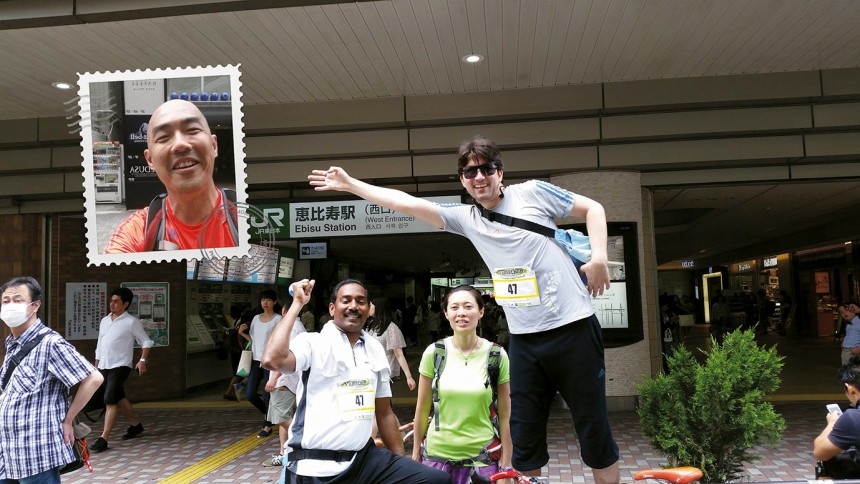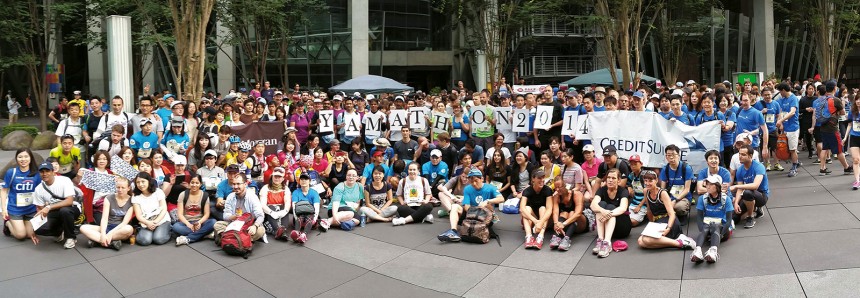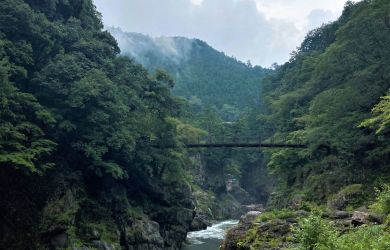
May 18, 2015
Yamathon Traces the Tracks
Rounding the Yamanote Line on foot for charity
The Yamanote Line, with its clockwork green and silver carriages, is one of the Tokyo landscape’s most famous fixtures. Stay here long enough, and you can name all 29 stations in order. Do it on a TV game show, and your team might win—maybe not money, but at least plastic dolls. But while all Tokyoites know this famous route, which loops the inner city in a shape that more resembles a chili pepper than a circle, most know it from the vantage point of the tracks and platforms. Getting to know this train line from the ground level is a true adventure in a concrete jungle. And there’s no better way to embark on the journey than the Tokyo Yamathon, a charity event that sends teams on a mission to visit all 29 stations—on foot—in one day.
First held in 2010, the Yamathon is a physical and navigational challenge that gives teams of three or four a chance to test endurance, have fun in the process, and raise money for a good cause. The event is organized by International Volunteer Group (IVG), which was founded in 2007 and was originally part of the worldwide development organization Oxfam. This year marks the seventh running.
Joe Pournovin, Events Director for IVG, explained how the Yamathon originally took shape. “We wanted to do something in Tokyo, some sort of endurance challenge. You look at certain other events … they’re expensive, you need to take time off work, you need to commit to training and practice. Yamathon, you don’t need to do so much training. It’s in the center of Tokyo, and it’s affordable.”
Affordable it is. The entry fee is just ¥10,000 per three- or four-person team, and 100% of the revenue is donated to NADIA, the NPO that IVG has partnered with this year to help the recovery of Ishinomaki in Miyagi prefecture.
NADIA, an international group of volunteers, was founded just after the March 2011 earthquake and tsunami, and became a registered NPO in Japan in January 2012. Since then, NADIA has made regular trips to Tohoku, with volunteers spending their weekends on the ground helping children. Partnering with Playground of Hope, NADIA has built 13 new playgrounds in areas in need, with more to come. Your support of this year’s Yamathon will help make this happen.

So what it is like to actually run—or walk—the Yamathon? This unique affair starts—and ends—at the Tokyo Tokia Building, just three minutes from Tokyo Station. Teams must visit all 29 stations on the Yamanote Line, and take a photo in front of each, in less than 12 hours. It’s an even playing field, whether the teams include adults, children, babies, or … “We’ve had dogs do the event. That’s the best thing about the event—anyone can do it,” says Pournovin. “Two groups had a toddler and a baby in a stroller. Really anybody can do it,” adds Kazumi Nono, Head of Strategy for IVG.
While the playing field is the same, and a basic course is established, teams are encouraged to get creative and have the freedom to pick their own route. As long as you get your 29 photos and return to home base within 12 hours, the rest is up to you.
Ronald Choi, Executive Director of Fixed Income Technology at J.P. Morgan, recounts his experience making the rounds of the roughly 40km course and what it’s really all about. “We reminded ourselves, this is not a race … this is a fundraiser, and we should have fun. So we stopped by to have a beer, have lunch. Most people do that, they stop and eat and drink and enjoy.”
Don’t feel like walking 40km but still want to be part of the fun? There’s so much more going on back at the Tokyo Tokia Building. This year, in addition to raising funds for Tohoku, IVG and NADIA are working very hard to bring Tohoku to Tokyo with the Tohoku Market, taiko groups, and the Imagination Playground, in which kids can build their own playground. There will also be a bar with a DJ, and even free massages. It’s a day for Tohoku—not only for participants, not only for volunteers, but for everyone who wants to come down and see what a difference people can make when they come together.
In the end, it’s all about fun, all about sharing the experience. But beyond that, Pournovin sums up the real reason 700 or more people form teams and run the Yamathon: “It feels good doing this. It’s rewarding. Making people smile is one of the most precious things you can do to someone. And that’s why I got involved.”
Want to get involved?
Form or find a team, volunteer, or just learn more:
Yamathon website
On Facebook
@TheYamathon on Twitter







